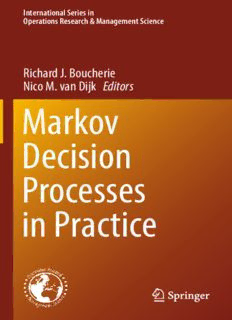Table Of ContentInternational Series in
Operations Research & Management Science
Richard J. Boucherie
Nico M. van Dijk Editors
Markov
Decision
Processes
in Practice
International Series in Operations Research
& Management Science
Volume 248
SeriesEditor
CamilleC.Price
StephenF.AustinStateUniversity,TX,USA
AssociateSeriesEditor
JoeZhu
WorcesterPolytechnicInstitute,MA,USA
FoundingSeriesEditor
FrederickS.Hillier
StanfordUniversity,CA,USA
Moreinformationaboutthisseriesathttp://www.springer.com/series/6161
Richard J. Boucherie • Nico M. van Dijk
Editors
Markov Decision Processes
in Practice
123
Editors
RichardJ.Boucherie NicoM.vanDijk
StochasticOperationsResearch StochasticOperationsResearch
UniversityofTwente UniversityofTwente
Enschede,TheNetherlands Enschede,TheNetherlands
ISSN0884-8289 ISSN2214-7934 (electronic)
InternationalSeriesinOperationsResearch&ManagementScience
ISBN978-3-319-47764-0 ISBN978-3-319-47766-4 (eBook)
DOI10.1007/978-3-319-47766-4
LibraryofCongressControlNumber:2017932096
©SpringerInternationalPublishingAG2017
Thisworkissubjecttocopyright.AllrightsarereservedbythePublisher,whetherthewholeorpartof
thematerialisconcerned,specificallytherightsoftranslation,reprinting,reuseofillustrations,recitation,
broadcasting,reproductiononmicrofilmsorinanyotherphysicalway,andtransmissionorinformation
storageandretrieval,electronicadaptation,computersoftware,orbysimilarordissimilarmethodology
nowknownorhereafterdeveloped.
Theuseofgeneraldescriptivenames,registerednames,trademarks,servicemarks,etc.inthispublication
doesnotimply,evenintheabsenceofaspecificstatement,thatsuchnamesareexemptfromtherelevant
protectivelawsandregulationsandthereforefreeforgeneraluse.
Thepublisher,theauthorsandtheeditorsaresafetoassumethattheadviceandinformationinthisbook
arebelievedtobetrueandaccurateatthedateofpublication.Neitherthepublishernortheauthorsor
theeditorsgiveawarranty,expressorimplied,withrespecttothematerialcontainedhereinorforany
errorsoromissionsthatmayhavebeenmade.Thepublisherremainsneutralwithregardtojurisdictional
claimsinpublishedmapsandinstitutionalaffiliations.
Printedonacid-freepaper
ThisSpringerimprintispublishedbySpringerNature
TheregisteredcompanyisSpringerInternationalPublishingAG
Theregisteredcompanyaddressis:Gewerbestrasse11,6330Cham,Switzerland
To
Carla,
Fabian,Daphne,Deirdre,andDanie¨l–
Thanksforbeingthereindifficulttimes,
Richard
P.Dorreboomandhisdaughter–
forcopingwithmypassions,
Nico
Foreword
Ihadthepleasureofservingastheserieseditorofthisseriesoveritsfirst20years
(from1993throughOctober,2013).Oneofthespecialpleasuresofthisworkwas
the opportunity to become better acquainted with many of the leading researchers
in our field and to learn more about their research. This was especially true in the
caseofNicoM.vanDijk,whobecameafriendandovernightguestinourhome.I
thenwasdelightedwhenNicoandhiscolleague,RichardJ.Boucherie,agreedtobe
theeditorsofahandbook,QueueingNetworks:AFundamentalApproach,thatwas
publishedin2010asVol.154inthisseries.Thisoutstandingvolumesucceededin
definingthecurrentstateoftheartinthisimportantarea.
Because of both its elegance and its great application potential, Markov deci-
sion processes have been one of my favorite areas of operations research. A full
chapter (Chap.19 in the current tenth edition) is devoted to this topic in my text-
book(coauthoredbythelateGeraldJ.Lieberman),IntroductiontoOperationsRe-
search. However, I have long been frustrated by the sparsity of publications that
describe applications of Markov decision processes. This was less true about 30
yearsagowhenD.J.Whitepublishedhisseminalpapersonsuchrealapplications
inInterfaces(seetheNovember–December1985andSeptember–October1988is-
sues). Unfortunately, relatively few papers or books since then have delved much
into such applications. (One of these few publications is the 2002 book edited by
Eugene Feinberg and Adam Shwartz, Handbook of Markov Decision Processes:
MethodsandApplications,whichisVol.40inthisseries.)
Given the sparse literature in this important area, I was particularly delighted
whentheoutstandingteamofNicoM.vanDijkandRichardJ.Boucherieaccepted
my invitation to be the editors of this exciting new book that focuses on Markov
decisionprocessesinpractice.Oneofmylastactsastheserieseditorwastowork
withthesecoeditorsandthepublisherinshepherdingthebookproposalthroughthe
processofprovidingthecontractforitspublication.Ifeelthatthisbookmayprove
vii
viii Foreword
tobeoneofthemostimportantbooksintheseriesbecauseitshedssomuchlight
onthegreatapplicationpotentialofMarkovdecisionprocesses.Thishopefullywill
leadtoarenaissanceinapplyingthispowerfultechniquetonumerousrealproblems.
StanfordUniversity FrederickS.Hillier
July2016
Preface
It is over 30 years ago since D.J. White started his series of surveys on practical
applicationsofMarkovdecisionprocesses(MDP),1,2,3 over20yearsafterthephe-
nomenalbookbyMartinPutermanonthetheoryofMDP,4 andover10yearssince
Eugene A. Feinberg and Adam Shwartz published their Handbook of Markov De-
cisionProcesses:MethodsandApplications.5 Inthepastdecades,thepracticalde-
velopmentofMDPseemedtohavecometoahaltwiththegeneralperceptionthat
MDPiscomputationallyprohibitive.Accordingly,MDPisdeemedunrealisticand
isoutofscopeformanyoperationsresearchpractitioners.Inaddition,MDPisham-
pered by its notational complications and its conceptual complexity. As a result,
MDP is often only briefly covered in introductory operations research textbooks
andcourses.Recentlydevelopedapproximationtechniquessupportedbyvastlyin-
creasednumericalpowerhavetackledpartofthecomputationalproblems;see,e.g.,
Chaps.2 and 3 of this handbook and the references therein. This handbook shows
thatarevivalofMDPforpracticalpurposesisjustifiedforseveralreasons:
1. First and above all, the present-day numerical capabilities have enabled MDP
tobeinvokedforreal-lifeapplications.
2. MDPallowstodevelopandformallysupportapproximateandsimplepractical
decisionrules.
3. Lastbutnotleast,MDP’sprobabilisticmodelingofpracticalproblemsisaskill
ifnotartbyitself.
1D.J.White.RealapplicationsofMarkovdecisionprocesses.Interfaces,15:73–83,1985.
2D.J.White.FurtherrealapplicationsofMarkovdecisionprocesses.Interfaces,18:55–61,1988.
3D.J.White.ASurveyofApplicationsofMarkovDecisionProcesses.JournaloftheOperational
ResearchSociety,44:1073–1096,1993.
4 Martin Puterman. MarkovDecisionProcesses:DiscreteStochasticDynamicProgramming.
Wiley,1994.
5 Eugene A. Feinberg and Adam Shwartz, editors. HandbookofMarkovDecisionProcesses:
MethodsandApplications.Kluwer,2002.
ix
x Preface
This handbookMarkovDecisionProcessesinPracticeaimstoshowthepower
ofclassicalMDPforreal-lifeapplicationsandoptimization.Thehandbookisstruc-
turedasfollows:
PartI: GeneralTheory
PartII: Healthcare
PartIII: Transportation
PartIV: Production
PartV: Communications
PartVI: FinancialModeling
The chapters of Part I are devoted tothestate-of-the-arttheoreticalfoundationof
MDP,includingapproximatemethodssuchaspolicyimprovement,successiveap-
proximation and infinite state spaces as well as an instructive chapter on approx-
imate dynamic programming. Parts II–VI contain a collection of state-of-the-art
applicationsinwhichMDPwaskeytothesolutionapproachin a non-exhaustive
selectionofapplicationareas.Theapplication-orientedchaptershavethefollowing
structure:
• Problemdescription
• MDPformulation
• MDPsolutionapproach
• Numericalandpracticalresults
• EvaluationoftheMDPapproachused
Next to the MDP formulation and justification, most chapters contain numerical
resultsandareal-lifevalidationorimplementationoftheresults.Someofthechap-
tersarebasedonpreviouslypublishedresults,someareexpandingonearlierwork,
andsomecontainnewresearch.Allchaptersarethoroughlyreviewed.Tofacilitate
comparison of theresultsoffered indifferentchapters, several chapters contain an
appendix with notation or a transformation of their notation to the basic notation
providedinAppendixA.AppendixBcontainsacompactoverviewofallchapters
listingdiscreteorcontinuousmodelingaspectsandtheoptimizationcriteriausedin
differentchapters.
Theoutlineofthesesixpartsisprovidedbelow.
PartI:GeneralTheory
Thispartcontainsthefollowingchapters:
Chapter1: One-StepImprovementIdeasandComputationalAspects
Chapter2: ValueFunctionApproximationinComplexQueueingsystems
Chapter3: ApproximateDynamicProgrammingbyPracticalExamples
Chapter4: ServerOptimizationofInfiniteQueueingSystems
Chapter5: Structures of Optimal Policies in MDP with Unbounded Jumps: The
StateofOurArt
Preface xi
Thefirstchapter,byH.C.Tijms,presentsasurveyofthebasicconceptsunderly-
ingcomputationalapproachesforMDP.Focusisonthebasicprincipleofpolicyim-
provement,thedesignofasinglegoodimprovementstep,andone-stage-look-ahead
rules,to,e.g.,generatethebestcontrolruleforthespecificproblemofinterest,for
decompositionresultsorparameterization,andtodevelopaheuristicortailor-made
rule.Severalintriguingqueueingexamplesareincluded,e.g.,withdynamicrouting
toparallelqueues.
In the second chapter, by S. Bhulai, using one-step policy improvement is
broughtdowntotheessenceofunderstandingandevaluatingtherelativevaluefunc-
tionofsimplesystemsthatcanbeusedinthecontrolofmorecomplicatedsystems.
First,theessenceofthisrelativevaluefunctionisnicelyclarifiedbystandardbirth
deathM/M/squeueingsystems.Next,anumberofapproximationsfortherelative
valuefunctionareprovidedandappliedtomorecomplexqueueingsystemssuchas
fordynamicroutinginreal-lifemultiskilledcallcenters.
Chapter3,byMartijnMesandArturoPe´rezRivera,continuestheapproximation
approach and presents approximate dynamic programming (ADP) as a powerful
techniquetosolvelarge-scalediscrete-timemultistagestochasticcontrolproblems.
Ratherthanamorefundamentalapproachas,forexample,canbefoundintheexcel-
lentbookofWarrenB.Powell,6 thischapterillustratesthebasicprinciplesofADP
via three different practical examples: the nomadic trucker, freight consolidation,
andtacticalplanninginhealthcare.
The special but quite natural complication of infinite state spaces within MDP
isgiven special attention intwoconsecutive chapters. First,inChap.4,by Andra´s
Me´sza´ros and Miklo´s Telek, the regular structure of several Markovian models is
exploitedtodecomposeaninfinitetransitionmatrixinacontrollableanduncontrol-
lable part, which allows a reduction of the unsolvable infinite MDP into a numer-
ically solvable one. The approach is illustrated via queueing systems with parallel
serversandacomputersystemwithpowersavingmodeand,inamoretheoretical
setting,forbirth-deathandquasi-birth-deathmodels.
Next, in Chap.5, by Herman Blok and Floske Spieksma, emphasis is on struc-
tural properties of infinite MDPs with unbounded jumps. Illustrated via a running
example, the natural question is addressed, how structural properties of the opti-
malpolicyarepreservedundertruncationorperturbationoftheMDP.Inparticular,
smoothedratetruncation(SRT)isdiscussed,andaroadmapisprovidedforpreserv-
ingstructuralproperties.
6WarrenB.Powell.ApproximateDynamicProgramming:SolvingtheCursesofDimensionality.
WileySeriesinProbabilityandStatistics,2011.
Description:This book presents classical Markov Decision Processes (MDP) for real-life applications and optimization. MDP allows users to develop and formally support approximate and simple decision rules, and this book showcases state-of-the-art applications in which MDP was key to the solution approach. The b

